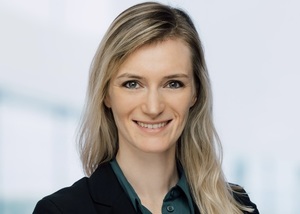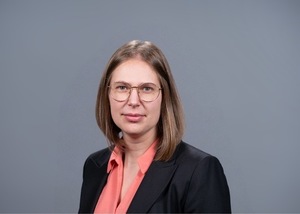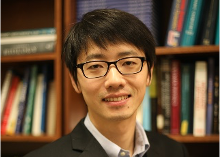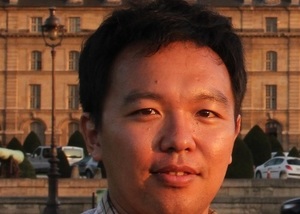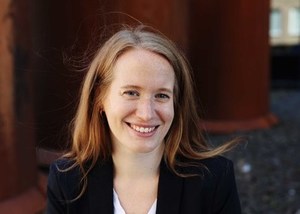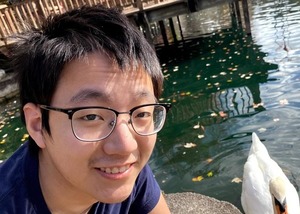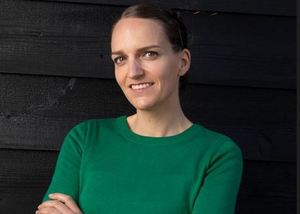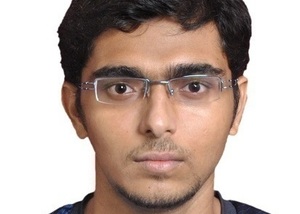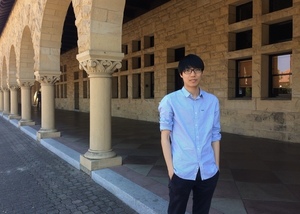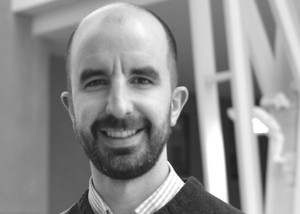Institute Talks
- Dr.-Ing. Renate Sachse
- Hybrid - Webex plus in-person attendance in Copper (2R04)
Soft robotics, an emerging field, focuses on creating flexible and adaptable robots inspired by the pliability found in living organisms. Developed through advancements in materials and manufacturing techniques, soft robots offer unique capabilities such as delicate object manipulation and safe human interaction. In soft robot design, the greatest challenge currently lies in identifying a structure capable of executing a targeted maneuver considering its intricate mechanical behavior. A possible design concept is to learn from biological systems and transfer the functionalities to biomimetic technologies. Recent advancements in soft robotics have turned to plants as inspiration, because they offer attractive characteristics such as resilience, self-healing, autonomy and continuous mechanisms. Hereby, the underlying biological cells act as a microstructure enabling a motion of the macrostructure and introducing intelligence into the system. Yet, before a biological function principle can be transferred to a biomimetic device, it must be fully understood. High-fidelity computer simulations are particularly suitable for analyzing biological motions within a so-called reverse biomimetics approach, but also for technical mechanisms. In this context, computational mechanics can be seen as an enabling technology, allowing for the representation of soft robots as the continuous and flexible structures they truly are. This talk aims to showcase my recent research efforts to integrate the two fields of computational mechanics and soft robotics deeply. Above all, my vision is to go even one step further and not only “reconstruct” the mechanical behavior of biomimetic soft robots through computational analysis, but also to advance methods in computational mechanics such that a systematic inverse design of these complex structures comes within reach.
Organizers: Katherine J. Kuchenbecker Christoph Keplinger
- Maria Korosteleva
- N3.022
The problems of creating new garments (modeling) or reproducing the existing ones (reconstruction) appear in various fields: from fashion production to digital human modeling for the metaverse. The talk introduces approaches to a novel garment creation paradigm: programming-based parametric sewing pattern construction and its application to generating rich synthetic datasets of garments with sewing patterns. We will then discuss how the availability of ground truth sewing patterns allows posing the learning-based garment reconstruction problem as a sewing pattern recovery. Such reformulation enables obtaining high-quality 3D garment models from sparse point clouds with effective design generalization while simultaneously providing designer-friendly garment representation for further use in traditional garment processing pipelines.
Organizers: Yao Feng Michael Black
Designing Mobile Robots for Physical Interaction with Sandy Terrains
- 18 March 2024 • 16:00—17:00
- Dr. Hannah Stuart
- Hybrid - Webex plus in-person attendance in Copper (2R04)
One day, robots will widely support exploration and development of unstructured natural environments. Much of the work I will present in this lecture is supported by NASA and is focused on robot design research relevant to accessing the surfaces of the Moon or Mars. Tensile elements appear repeatedly across the wide array of missions envisioned to support human or robotic exploration and habitation of the Moon. With a single secured tether either rovers or astronauts, or both, could belay down into steep lunar craters for the exploration of permanently shadowed regions; the tether prevents catastrophic slipping or falling and mitigates risk while we search for water resources. Like a tent that relies on tensioned ropes to sustain its structure, tensegrity-based antennae, dishes, and habitations can be made large and strong using very lightweight materials. We ask: Where does the tension in these lightweight systems go? Ultimately, these concepts will require anchors that attach cables autonomously, securely, and reliably to the surrounding regolith to react tensile forces. Thus, the development of new autonomous burrowing and anchoring technologies and modeling techniques to guide design and adoption is critical across multiple space relevant programs. Yet burrowing and anchoring problems are hard for multiple reasons, which remain fundamental areas of discovery. Our goal is to understand how the mechanics of granular and rocky interaction influences the design and control small-scale robotic systems for such forceful manipulations. I will present new mobility and anchoring strategies to enable small robots to resist, or "tug," massive loads in loose terrain, like regolith. The idea is that multiple tethered agents can work together to perform large-scale manipulations, even where traction and gravity is low. Resulting generalizable methods for rapidly modeling granular interactions also inform new mobility gaits to move over, through, or under loose sand more efficiently.
Organizers: Katherine J. Kuchenbecker
- Dr. Jianyu Li
- Silver (2P04)
Bioadhesive technologies are important in a wide range of applications, spanning from wound management to wearable technologies. Forming and controlling tough adhesion on biological tissues has been a long-lasting challenge, necessitating transdisciplinary approaches. In my talk, I will share our recent progress in the design, mechanics, and applications of tough bioadhesives. I will first discuss the limitations of clinically used surgical glues and blood clots in terms of adhesion properties. I will then present the mechanical principles for making tough bioadhesives that exhibit superior adhesion performance on diverse tissues. Furthermore, I will discuss our transdisciplinary approaches and underlying mechanisms for controlling tough bioadhesion through ultrasound and interfacial entanglements. Lastly, I will showcase the applications of tough bioadhesives in wound management, tissue repair, and hemorrhage control. This talk will highlight the synergy of materials and mechanics in the development of new biomaterials poised to address biomedical challenges.
Organizers: Christoph Keplinger Adrian Koh
- Qixing Huang
- N3.022
Generative models, which map a latent parameter space to instances in an ambient space, enjoy various applications in 3D Vision and related domains. A standard scheme of these models is probabilistic, which aligns the induced ambient distribution of a generative model from a prior distribution of the latent space with the empirical ambient distribution of training instances. While this paradigm has proven to be quite successful on images, its current applications in 3D generation encounter fundamental challenges in the limited training data and generalization behavior. The key difference between image generation and shape generation is that 3D shapes possess various priors in geometry, topology, and physical properties. Existing probabilistic 3D generative approaches do not preserve these desired properties, resulting in synthesized shapes with various types of distortions. In this talk, I will discuss recent work that seeks to establish a novel geometric framework for learning shape generators. The key idea is to model various geometric, physical, and topological priors of 3D shapes as suitable regularization losses by developing computational tools in differential geometry and computational topology. We will discuss the applications in deformable shape generation, latent space design, joint shape matching, and 3D man-made shape generation.
Organizers: Yuliang Xiu
- Marie Großmann
- Hybrid - Webex plus in-person attendance in 5N18
The sensory perception of the world, including seeing and hearing, tasting and smelling,touching and feeling, are necessary social skills to become a social counterpart. In this context,the construction of a perceptible technology is an intersection where technical artifacts have the capability to interact and sense their environment. Sensors as technical artifacts not only measure various (physical) states, with their presented results influencing perceptions and actions, but they also undergo technical and computational processing. Sensors generate differences by capturing and measuring variations in their surroundings. In this talk, I will share insights from my qualitative social research in the lab, using a sociological engagement with technology, materiality, and science research as a starting point to sharpen a sociological perspective on constructing technical perceptions. The focus will lie on how knowledge on perceptions is implemented in technology and materiality when constructing sensors.
Organizers: Katherine J. Kuchenbecker
- Luming Tang
- N3.022
Computer vision made huge progress in the past decade with the dominant supervised learning paradigm, that is training large-scale neural networks on each task with ever larger datasets. However, in many cases, scalable data or annotation collection is intractable. In contrast, humans can easily adapt to new vision tasks with very little data or labels. In order to bridge this gap, we found that there actually exists rich visual knowledge in large pre-trained models, i.e., models trained on scalable internet images with either self-supervised or generative objectives. And we proposed different techniques to extract these implicit knowledge and use them to accomplish specific downstream tasks where data is constrained including recognition, dense prediction and generation. Specifically, I’ll mainly present the following three works. Firstly, I will introduce an efficient and effective way to adapt pre-trained vision transformers to a variety of low-shot downstream tasks, while tuning only less than 1 percent of the model parameters. Secondly, I will show that accurate visual correspondences emerge from a strong generative model (i.e., diffusion models) without any supervision. Following that, I will demonstrate that an adapted diffusion model is able to complete a photo with true scene contents using only a few casual captured reference images.
Organizers: Yuliang Xiu Yandong Wen
Biomechanics and Control of Agile Locomotion: from Walking to Jumping
- 07 December 2023 • 11:30—12:30
- Dr. Janneke Schwaner
- Hybrid - Webex plus in-person attendance in 5N18
Animals seem to effortlessly navigate complex terrain. This is in stark contrast with even the most advanced robot, illustrating that navigating complex terrain is by no means trivial. Humans’ neuromusculoskeletal system is equipped with two key mechanisms that allow us to recover from unexpected perturbations: muscle intrinsic properties and sensory-driven feedback control. We used unique in vivo and in situ approaches to explore how guinea fowl (Numida meleagris) integrate these two mechanisms to maintain robust locomotion. For example, our work showed a modular task-level control of leg length and leg angular trajectory during navigating speed perturbations while walking, with different neuromechanical control and perturbation sensitivity in each actuation mode. We also discovered gait-specific control mechanisms in walking and running over obstacles. Additionally, by combining in vivo and in situ experimental approaches, we found that guinea fowl LG muscles do not operate at optimal muscle lengths during force production during walking and running, providing a safety factor to potential unexpected perturbations. Lastly, we will also highlight some work showing how kangaroo rats circumvent mechanical limitations of skeletal muscles to jump as well as how these animals overcome angular momentum limitations during aerial reorientation during predator escape leaps. Elucidating frameworks of functions, adaptability, and individual variation across neuromuscular systems will provide a stepping-stone for understanding fundamental muscle mechanics, sensory feedback, and neuromuscular health. Additionally, this research has the potential to reveal the functional significance of individual morphological, physiological, and neuromuscular variation in relation to locomotion. This knowledge can subsequently inform individualized rehabilitation approaches and treatment of neuromuscular conditions, such as stroke-related motor impairments, as they require an integrated understanding of dynamic interactions between musculoskeletal mechanics and sensorimotor control. This work also provides foundational knowledge for the development of dynamic assistive devices and robots that can navigate through complex terrains.
Organizers: Katherine J. Kuchenbecker Andrew Schulz
RAVEN: Rethinking Adversarial Video generation with Efficient tri-plane Networks
- 30 November 2023 • 10:00 am—11:00 am
- Partha Ghosh
- N3.022 Aquarium and Zoom
We present a novel unconditional video generative model designed to address long-term spatial and temporal dependencies. To capture these dependencies, our approach incorporates a hybrid explicit-implicit tri-plane representation inspired by 3D-aware generative frameworks developed for three-dimensional object representation and employs a singular latent code to model an entire video sequence. Individual video frames are then synthesized from an intermediate tri-plane representation, which itself is derived from the primary latent code. This novel strategy reduces computational complexity by a factor of 2 as measured in FLOPs. Consequently, our approach facilitates the efficient and temporally coherent generation of videos. Moreover, our joint frame modeling approach, in contrast to autoregressive methods, mitigates the generation of visual artifacts. We further enhance the model's capabilities by integrating an optical flow-based module within our Generative Adversarial Network (GAN) based generator architecture, thereby compensating for the constraints imposed by a smaller generator size. As a result, our model is capable of synthesizing high-fidelity video clips at a resolution of 256×256 pixels, with durations extending to more than 5 seconds at a frame rate of 30 fps. The efficacy and versatility of our approach are empirically validated through qualitative and quantitative assessments across three different datasets comprising both synthetic and real video clips.
Organizers: Yandong Wen
Orthogonal Butterfly: Parameter-Efficient Orthogonal Adaptation of Foundation Models via Butterfly Factorization
- 19 October 2023 • 10:00 am—11:00 am
- Weiyang Liu
- N3.022 Aquarium and Zoom
Large foundation models are becoming ubiquitous, but training them from scratch is prohibitively expensive. Thus, efficiently adapting these powerful models to downstream tasks is increasingly important. In this paper, we study a principled finetuning paradigm -- Orthogonal Finetuning (OFT) -- for downstream task adaptation. Despite demonstrating good generalizability, OFT still uses a fairly large number of trainable parameters due to the high dimensionality of orthogonal matrices. To address this, we start by examining OFT from an information transmission perspective, and then identify a few key desiderata that enable better parameter-efficiency. Inspired by how the Cooley-Tukey fast Fourier transform algorithm enables efficient information transmission, we propose an efficient orthogonal parameterization using butterfly structures. We apply this parameterization to OFT, creating a novel parameter-efficient finetuning method, called Orthogonal Butterfly (BOFT). By subsuming OFT as a special case, BOFT introduces a generalized orthogonal finetuning framework. Finally, we conduct an extensive empirical study of adapting large vision transformers, large language models, and text-to-image diffusion models to various downstream tasks in computer vision and natural language. The results validate the effectiveness of BOFT as a generic finetuning method.
Organizers: Yandong Wen
- Dr. Diego Ospina
- Hybrid - Webex plus in-person attendance in 5N18
Project neuroArm was established in 2002, with the idea of building the world’s first robot for brain surgery and stereotaxy. With the launch (2007) and integration of the neuroArm robot in the neurosurgical operating room (May 2008), the project continues to spawn newer technological innovations, advance tele-robotics through sensors and AI, and intelligent surgical systems towards improving safety of surgery. This talk will provide a high-level overview of two such technologies the team at Project neuroArm is currently developing and deploying: i) neuroArm+HD, a medical-grade sensory immersive workstation designed to enhance learning, performance, and safety in robot-assisted microsurgery and tele-operations; and ii) SmartForceps, a sensorized surgical bipolar forceps for real-time recording, displaying, monitoring, and uploading of tool-tissue interaction forces during surgery.
Organizers: Katherine J. Kuchenbecker Rachael Lorsa

